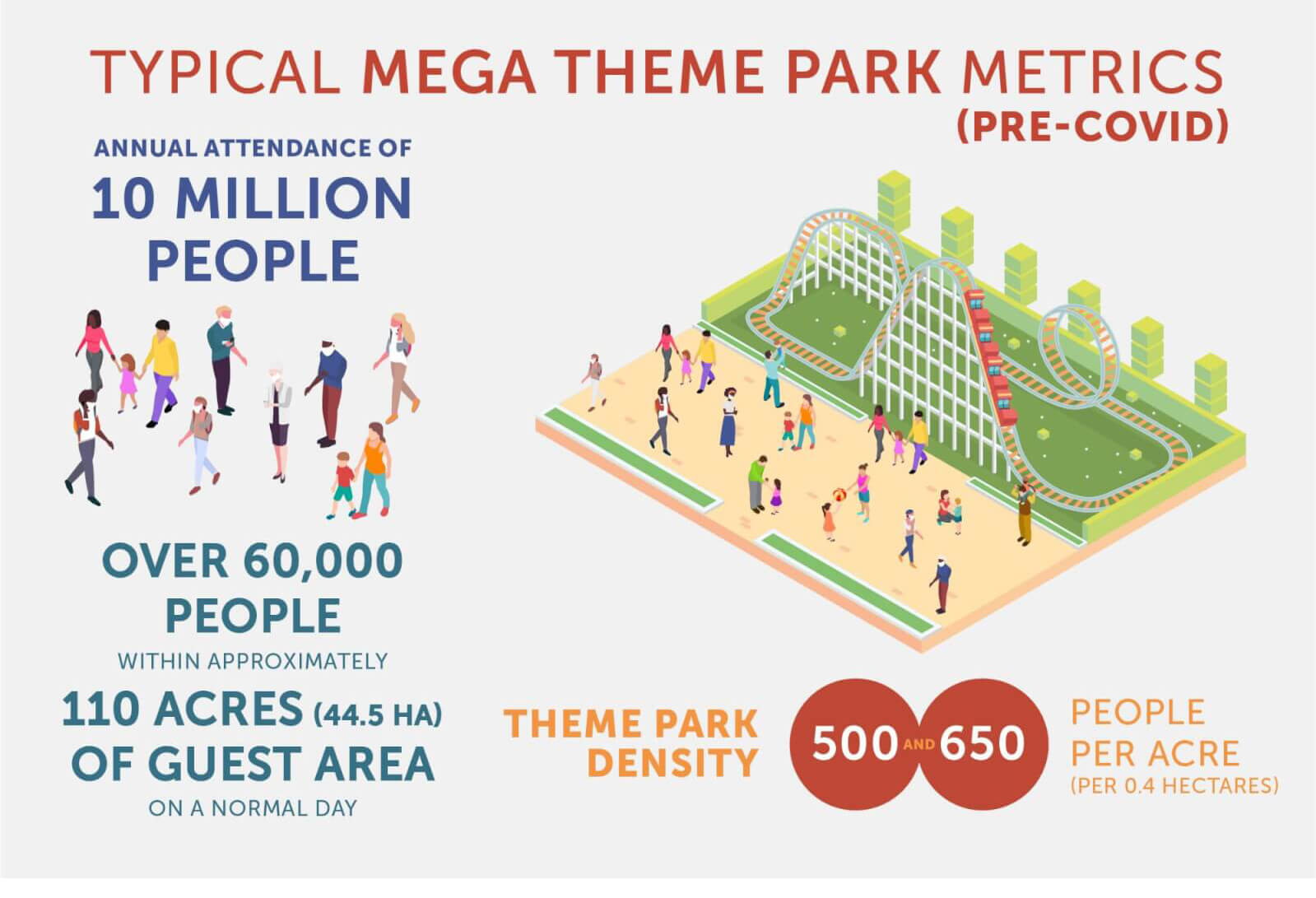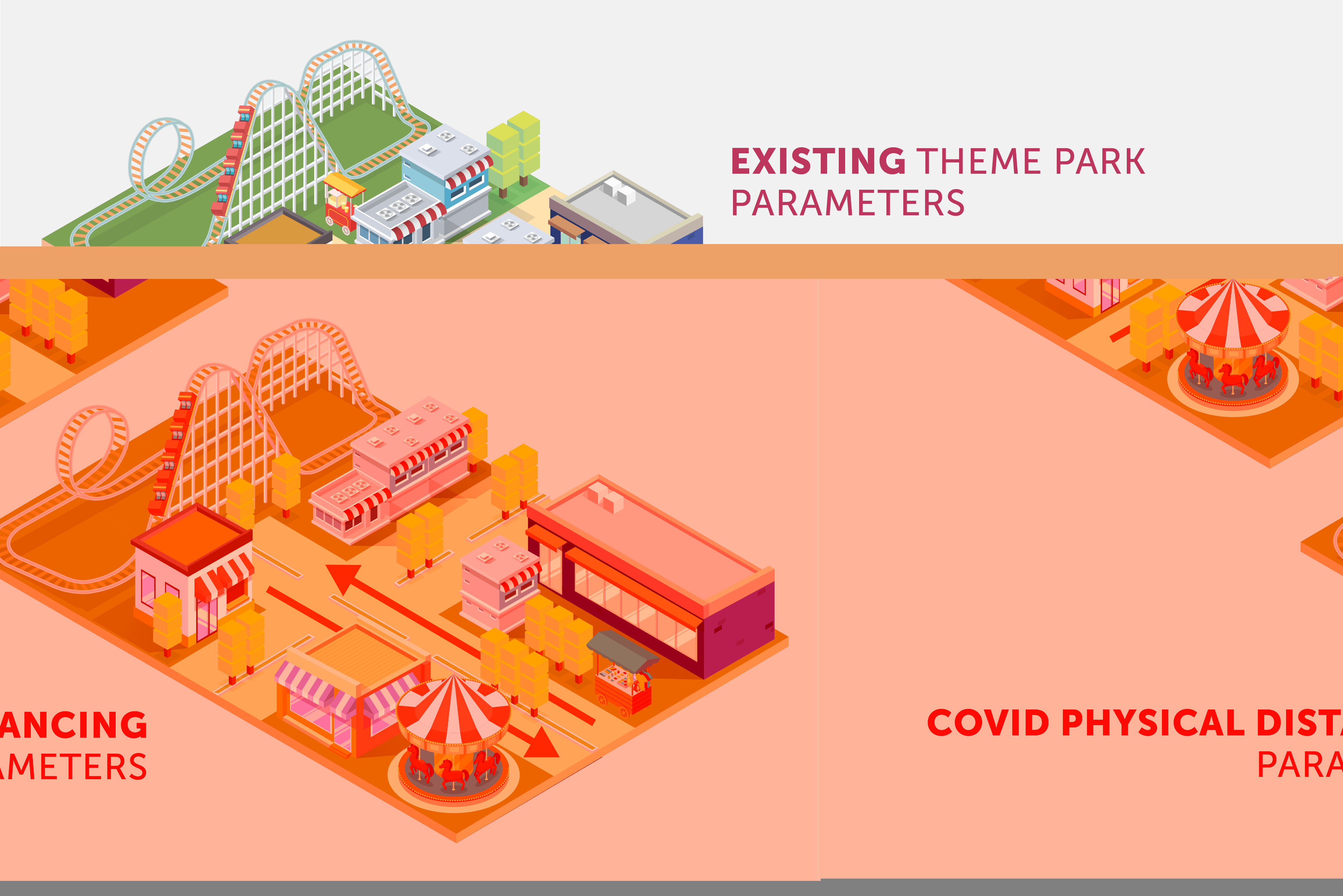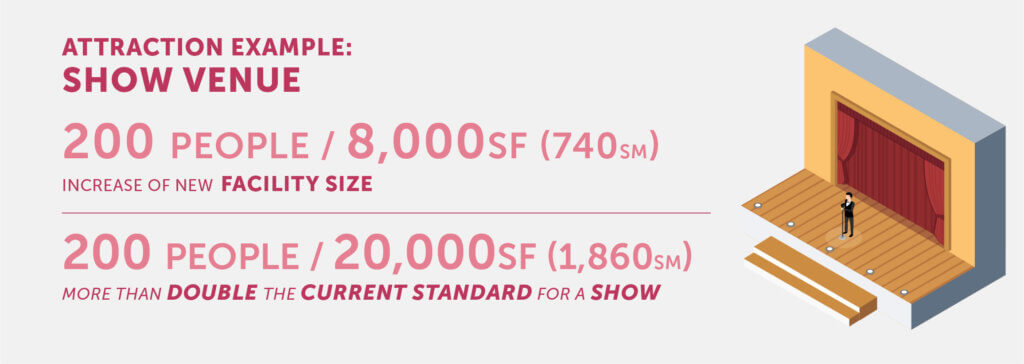Designing a Physically Distanced Theme Park
- White Papers
WHAT IF…
…we designed a theme park with physical distancing and health-safety as guiding principles?
 Disney Shanghai has opened its doors at reduced capacity to allow visitors space to learn the “new norms”, such as spacing out within a queue and frequent hand sanitizing and facility wipe downs. A “mega theme park” like the Disney or Universal parks typically means an annual attendance of over 10 million people, and over 60,000 people within approximately 110 acres of guest area on a normal day.
Disney Shanghai has opened its doors at reduced capacity to allow visitors space to learn the “new norms”, such as spacing out within a queue and frequent hand sanitizing and facility wipe downs. A “mega theme park” like the Disney or Universal parks typically means an annual attendance of over 10 million people, and over 60,000 people within approximately 110 acres of guest area on a normal day.
In these mega theme parks, visitors make their way down crowded streets, pack in to get a glimpse of a passing parade, and stand together in long queues to enjoy the amazing attractions together. A general rule of thumb for theme park density is between 500 and 650 people per acre (per 0.4 Hectares).
What if we want to design a park that meets this level of capacity, and also allows for the current recommendations on physical distancing? There are many new and innovative technologies and operating methods that will be able to assist in this effort moving forward, but what would it take using the existing tools and methodologies commonly practiced today and designed a park around those needs and parameters?
Personal Space
 Space is the major commodity when talking about physical distancing. During a typical summer weekend day at a theme park, visitors often find themselves walking in a crowd, frequently having to stop momentarily or making frequent course corrections to avoid bumping others. This indicates a density of 10-15 square feet, sf (1-1.4 square meters, sm) per person within the circulation space, and if there’s a parade or a sudden character appearance, that density may go down to 5 sf (0.46 sm) per person, meaning that people will be brushing into each other and their movement will be severely restricted until the gathering disperses. These factors are what drive many theme parks to create “travel lanes” around parades or performance areas to allow the movement of people to still flow, albeit still at a reduced rate. The graphic above highlights:
Space is the major commodity when talking about physical distancing. During a typical summer weekend day at a theme park, visitors often find themselves walking in a crowd, frequently having to stop momentarily or making frequent course corrections to avoid bumping others. This indicates a density of 10-15 square feet, sf (1-1.4 square meters, sm) per person within the circulation space, and if there’s a parade or a sudden character appearance, that density may go down to 5 sf (0.46 sm) per person, meaning that people will be brushing into each other and their movement will be severely restricted until the gathering disperses. These factors are what drive many theme parks to create “travel lanes” around parades or performance areas to allow the movement of people to still flow, albeit still at a reduced rate. The graphic above highlights:
- Pre-COVID Personal Space = 10-15 sf (1-1.4 sm) per person
- Post-COVID Personal Space = 140 sf (13 sm), 6 feet (1.8 meters) between individuals
- Post-COVID Group of Three = 200 sf (18.6 sm) for group and 67 sf (6.2 sm) individually

The arrival sequence at a park usually starts with a personal family vehicle, a coach-bus, or a form of public transportation such as a bus or a train. The impact of current COVID distancing recommendations will have an impact on how quickly people can arrive at the park, as well as the spatial requirements to receive them at the front gate. The expanded requirements for these spaces and arrival systems are not directly considered in this study, but because those are specific location-based factors.
Assuming people will be arriving and traveling through the park in small groups the individual space recommendations will overlap to reduce the spatial distance requirements. The space between people would include the paved areas, as well as the landscaped areas, which will further help with space planning. This does not take into account that parks are typically designed with crossing routes and plazas, which will now have to be more formally organized to create linear flows of traffic and avoid congestion. An easy way to think of this is a downtown urban grid of one-way streets, or maybe more relatable, an IKEA store which is filled with travel lanes.
Retail

Retail is a key component in the theme park program and an important asset to the visitor. Many of the modern theme park retail designs already lead visitors through a system of thematic spaces, departments, and purchasing opportunities that gently guide them through the stores. This would have to change to a more strict one-way aisle system, where displays can also act as a germ barrier between aisles. There would also need to be a greater allowance for staff positions throughout the store, as visitors would have restricted availability to touch items. Referring again to the rule of thumb, it can be assumed that 15% of the park population at any given moment is shopping, and the average allocation of space per person is 14 sf (1.3 sm), but with the COVID requirements a group of 3 will need approximately 80 sf (7.4 sm), less than walking down the street, requiring a 180% increase in parkwide retail facilities.
Food and Beverage
Dining opportunities within the theme park will present the challenge of allowing people to sit in groups and dwell for an extended period of time while they eat. Typically, food facilities require about twice as much space as retail shops for approximately the same amount of people including dining patios, indoor seating, and kitchen areas. With the new factors, a table for four may need around 100 sf (9.2 sm) instead of just 40 sf (3.7 sm). In addition, there will need to be space accommodations for food preparation and service. These factors would require the food facilities in this new park to become approximately 150% larger than current theme parks.
Attractions and Shows

Attractions are the big draw of theme parks; coasters, dark rides, theatrical shows, and walk-through experiences will all be impacted by increased personal space requirements. While the impact of increased personal space will vary based on the type of attraction, a show venue is one of the most densely populated attractions in a theme park. A typical show venue that seats 200 people can be 8,000 sf (740 sm) or more. A person seated in the theater takes up about 5 square feet (0.46 sm), with an additional 35 sf (3.2 sm) going toward the overall facility. Now that personal space requirement will be 67sf (6.2 sm), bringing the overall facility size to over 20,000sf (1,860 sm)—more than double the current standard for a show.
Conclusion

 From a simple space planning perspective focusing on the physical distancing recommendations, the theme park circulation will have to increase 100%, the retail by 180%, food service by 150%, and attraction areas from 150-200%. These factors, applied to the entire theme park property, result in a 110 acre (44.5 Ha) theme park growing to over 200 acres (89 Ha) to accommodate the same daily attendance.
From a simple space planning perspective focusing on the physical distancing recommendations, the theme park circulation will have to increase 100%, the retail by 180%, food service by 150%, and attraction areas from 150-200%. These factors, applied to the entire theme park property, result in a 110 acre (44.5 Ha) theme park growing to over 200 acres (89 Ha) to accommodate the same daily attendance.
Discussing this thought exercise with Entertainment + Culture Advisors, ECA, it is important to note not only the space implications, but also the cost and revenue considerations:
“Revenue for a mega park is a product of attendance and guest spend. New constraints on capacity could shift the business model to identify new premiums in guest spend. The focus will be on pricing as significant increases in retail or dining spend are unlikely if length of stay is the same or less. Pricing in the industry was already moving toward peak admission pricing tiers and express passes and this trend will accelerate if capacities are further constrained. Depending on the premiums required for the business model, the response from the market may be reduced demand that rebalances the sizing needs of new mega parks to lower attendance thresholds that serve more expensive and exclusive experiences.”
Also noted by ECA, the cost and revenue impacts for a mega theme park will not only be limited to the theme park and increased spatial requirements, but also the context of hotels, retail, and mixed-use development. A mega theme park by definition is part of a larger development with many integrated program uses and functions.
This thought exercise purposefully does not take into consideration all of the creative thinking and innovative approaches being used by operators and designers around the world to quickly help reduce the impact of this pandemic on our opportunities for safe and enjoyable experiences but simply focuses on the potential implications of physical distancing. As the world continues to learn from this experience, a mixture of spatial planning, smart design, and new technologies will help to create a more realistic interpretation of theme park design which fits within achievable parameters while still keeping visitors safe during their time at the park.
Related Posts
Disability Access: In It for the Long Haul
- White Papers
In May 2021, Thinkwell and RUH Global began a series...
Trend Report Deep Dive: Taming the Algorithm
- White Papers
The “Algorithm.” As a colloquial term for the recommendation engines...
Access for All
- White Papers
The wheelchair access queue line, the closed-captioning on a ride...